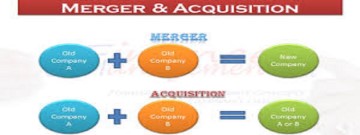Introduction – Differences Between Mergers and Acquisitions
When companies join together or collaborate the two most common procedures are to undertake either a merger or acquisition. Event driven investment strategies often focus on the eventual outcome of the corporate action. However, it is important to understand the differences between mergers and acquisitions and how these corporate events both overlap and differ in order to profit from merger arbitrage.
Key points – Mergers and Acquisitions Explanations
- The terms “Mergers and Acquisitions” have become increasingly synonymous as the industry evolves
- Company mergers occur when two or more separate entities combine to create a new enlarged single organization
- Acquisitions refer to the takeover and control of the target entity by the acquirer
- We explain key differences between the two corporate actions on an individual topic basis with acquisition examples and merger examples
Synopsis – Differences Between Mergers and Acquisitions
Mergers and acquisitions are two of the most common corporate restructuring strategies available to businesses. However, the terms “mergers” and “acquisitions” or often used as synonyms and in the news are reported as such. Indeed, it is common to find practitioners in the world of finance using both terms interchangeably. Acquisitions can sometimes carry a negative connotation because the term depicts an aggressive move by an acquirer to consume a target. To soften this negative connotation, PR departments try to portray the acquisition process, or takeover, as a company merger. This is one way the terms “merger” and “acquisition” often end up becoming interchangeable.
As we shall see, despite some common features there are distinct differences between mergers and acquisitions. We remind the reader we are discussing a constantly evolving topic. A particular deal may have its own unique set of circumstances and may defy the “rule of thumb”. Merger Arbitrage Limited has produced this guide which places great emphasis on M&A in the securities markets especially target companies that have publicly traded stock. In addition to explaining the importance of key differences within each topic area, this article also
- Demonstrates how and when a merger or acquisition is taking place
- Explains what effect (if any) this will have on the process of merger arbitrage
- Highlights key terminology (A separate comprehensive Glossary is also available)
- Lists additional resources for traders/market practitioners
The Differences Between Mergers and Acquisitions
Strategic Rational
The most striking similarity between a merger and an acquisition is the strategic end goal of the organisation. The organisation continuously attempts to maximize profit and create shareholder value. It is in the pursuit of these vital strategic objectives that the terms become synonymous and used interchangeably. A company often undertakes a merger or acquisition to expand its reach or gain market share.
Industry Position
In a mature industry where sales growth is restricted, companies may embark of a program of cost cutting. This may motivate larger companies to merge and eliminate cost overlaps whilst retaining the combined sales volume. This course of action is often termed a horizontal merger or acquisition which we explain in greater detail in a separate article. However, the industry position of the companies involved within the wider economic picture may dictate the necessary course of corporate action. In an expanding industry, an aggressive growth company may continuously acquire smaller start-ups with niche technology elements to help fuel further growth.
Cisco (CSCO) is a good example of this acquisitive strategy. The Boston Growth Matrix is an ideal way to quickly assess the state of a given product or industry. Alternatively, companies that are exposed to supplier risk and seek greater control over additional parts of the value chain may embark on a string of vertical takeovers as opposed to a merger of equals. We discuss this point in a stand alone article – Vertical Mergers With Examples – A Complete Guide.

Company Size
Merging companies tend to be of similar size. Sometimes, when the combination is considered a good strategic decision there is no clear senior partner. This results in a merger. When companies of roughly equal size and stature choose to merge, market observers often refer to the situation as a “merger of equals”. When the size of the acquirer (in terms of market capitalization) is clearly larger than the target, the parties will usually structure the deal as an acquisition.
Power
Size alone may not always explain the power difference between the two companies. Although this is the most common metric, technology, patents, personnel, customer base etc. are also vital. In a merger, the net outcome of these factors will tend to be equal. They may be complimentary factors, which may help reinforce market position. Alternatively, they may overlap, which offers the potential for cost cutting. Therefore, merging companies typically have equal say when discussing the terms of the merger.
When it is clear that one party has greater power, the deal structure is more likely to be an acquisition. There is less need for the acquirer to negotiate and so the acquiring company will dictate the majority of the terms.
Terms
Mergers are almost impossible to complete in a hostile manner as the process needs to blessing of both parties. This is because they are voluntary and mutually beneficial for both companies involved. Simply rebuffing the offer of a merger is enough to maintain independence. Therefore, mergers are a more friendly corporate restructuring strategy.
An acquisition however may be either hostile of friendly. Although the hostile takeovers by the corporate raiders in the past are now more the stuff of legend. Hostile approaches are rare in today’s market but they do occasionally occur. These deals clearly have more risk attached and thus greater spreads. (Click here for a list of current merger arbitrage spreads). Sometimes a takeover approach can begin as a hostile one. As more dialogue takes place between the companies, the deal proposal often turns friendly. This is in part the fiduciary duty of the directors to maximize shareholder value.
However, acquisitions are not always hostile. Friendly acquisitions may originate for a number of reasons. In these cases, the arbitrage spreads will tend to be narrower and less profitable. However, the risk will be lower.
Timeframe
Timeframes for mergers can extend for a long time. This is generally because the companies involved are larger and thus have more moving parts to integrate. There is also a greater possibility of regulatory clearance required in multiple jurisdictions. Complications with regulators can cause delays and deal extensions whilst destroying the annualized return of merger arbitrage.
Acquisitions however can range in size across the full spectrum. Naturally, smaller deals with less complications will be expected to close faster. They will also tend to have smaller spreads. Acquisitions may also be made by way of a tender offer. The proposal to buy the outstanding target stock is made directly to the target shareholders. This too can speed up the deal process.
Tax
Mergers and acquisitions may also complete for tax reasons or in addition to a stated corporate strategy. Firms often have the option of making the process a taxable or a non-taxable process, depending on what is more profitable. Federal tax laws weigh on the determination of whether the parties choose to enter into an acquisition or a merger. This tends to have greater consequences for the target stockholders and can depend on the method of payment.
Payment
In a merger, no cash payment necessary, it is simply the combination of entities. Shareholders receive new stock in the combined entity depending on the terms of the deal. It is unlikely the combination results in an exactly equal 50-50 split. This is a continuation of the stockholding. There is rarely an opportunity for an arbitrageur to profit from this situation. Two company’s combine, neither of who is paying a premium for the other. Virtually all (of any) stock price increase accrues to the existing stockholders.
An acquisition however can result in a cash payment, a payment in stock, or a combination of both. There are more advanced structures such as CVR’s but we will leave them aside for now. Stock payments usually occur in larger deals as arranging for this amount of cash can be expensive. However, some companies like to maintain their debt-to-equity ratio and may issue new stock in accordance with this policy. This issuance of new stock may inject an additional hurdle to the acquisition. Acquiring company stockholders may need to approve the decision if issuance is above a given threshold. This may cause a marginally wider spread. The arbitrageur subsequently takes a short position in the acquirer stock in the correct ratio in addition to the long target position.
Cash only acquisitions (or cash only deals) are the simplest. Payment is from funds on hand or the acquirer arranges additional borrowing. Arbitrageurs must be able to confirm the source of funds and establish that financing is not a risk factor. The acquirer purchases target stock for a fixed amount and the target shareholder deposits the proceeds. The spread or uncertainty that the deal will consummate is where the arbitrageur can make a profit.

Legal
Legally, a merger requires two or more companies to consolidate into a new entity with a new ownership and management structure. Although this will be comprised primarily from members of each firm. The joining companies cease to exist and the new company takes their place. A merger requires the formation of a new company, with many legal formalities and procedures.
This regulatory burden is somewhat reduced for an acquisition. When a company acquires a target, as per the law, the target ceases to exist. Delaware General Corporate Law (DGCL) has separate sections of its code dealing with acquisitions and mergers. However, these are established procedures and rarely require closer inspection by the arbitrageur. In both instances, companies will still need to make an HSR filing however and demonstrate that competition will not be reduced.
Title
During a merger and the formation of a new company, the new entity often takes a new name. An exception maybe if a company name has significant brand awareness.
On the other hand, an acquisition does not require the formation of a new company. Therefore, the acquired company becomes part of the acquirer business and operates under that name. In rare instances, a target continues trading as a separate unit and continues trading under its own name. When eBay bought PayPal in 2002, PayPal continued trading as PayPal. EBay made extensive use of the PayPal service within its business but it remained a separate business unit. This made the disposal by eBay a favorite topic for analysts some years later once PayPal had established itself as a stand-alone business.
Integration
Many mergers and acquisitions that fail do so because they cannot integrate properly. This may be due to a clash of cultures or even an incorrect assessment of talent. Mergers tend to require a greater level of cooperation between the parties working as equals. This cooperation helps to reduce the likelihood of post integration failure.
Acquisitions occasionally give the acquirer a superiority complex. This leaves them unable to fully appreciating the nuances of the target organisation at the granular level or fully understand how their companies will interplay with one another. Fortunately, post completion issues such as integration do not trouble the arbitrageur as by this time the position is closed. They can cause an issue however during the closing process if differences cannot be resolved. In the worst case, this can lead to deal failure.
Personnel
The merger is a strategic decision that has been done after careful discussion and planning between the companies that are going to merge. Hence, discussions of key positions as well as how teams will work and chains of command take place well in advance of deal completion. This greatly reduces the chances of a chaotic atmosphere after merging. If these plans are not in place, and one of the two parties was unhappy, the merger would not likely take place.
The acquisition on the other hand is not a mutual decision. This can create high levels of hostility after an acquisition. Fear and uncertainty surrounding job security become the main concern for employees. However, if the rationale behind a merger is to cut costs, it is inevitable jobs will be cut during the merger process.
However, once again, this is an after the fact issue for a merger arbitrageur. The main concern is whether or not job cuts or employee unrest may derail the deal before it is completed. It is quite often than local government officials may intervene if jobs are at stake if only to make a name for themselves. The threat of interference may be enough for an acquirer to rethink their strategy.
Ownership Differences Between Mergers and Acquisitions
Mergers require no cash to complete but dilute each company’s individual power. The result for stockholders is a smaller ownership of a larger entity. Since merging companies generally consider themselves equals (more or less), both companies surrender their existing stock and issue new stock. As mentioned, ownership is rarely exactly 50-50, but the final figure is not far from this.
An acquisition can also issue new stock to pay for the target or pay in cash. Sometimes there is a combination, and sometimes the target shareholders can choose between the alternative payment methods. If payment is in stock, the original target shareholders become shareholders in the existing acquirer firm. The acquiring company’s stocks continue to trade as before. This is not a new firm or new stock per se. (It could be existing treasury stock). However, situations such as these blur the lines between a merger and an acquisition.
The arbitrageur has no interest in continuity of ownership. Payment in acquirer requires the arb to short this stock whilst simultaneously buying the target stock. The focus becomes whether the method of payment is sufficient to convince the target stockholders to vote in favour of the deal.

Who Benefits?
Once news of the merger or acquisition filters into the market, the effect is immediately visible in the share prices of the companies involved. In a merger, increases in both stock prices are common but are muted. This movement depends on the potential gains the combined entity can deliver either through savings or sales improvements. It is unlikely the arbitrageur can significantly benefit from this situation.
In an acquisition, the target stock price rises dramatically towards the offer price. The arb now chooses whether to buy at this inflated price and profit from the spread. Often the acquirer stock price declines as the market judges the perceived benefits of such a capital out lay. If payment is in acquirer stock, the acquirer price is almost certain to fall as the arb short the stock to remain hedged. Therefore, the target stockholders usually benefit the most. Following the deal completion, subsequent stockholders of the surviving entity will have to wait and see how the proposed benefits of the merger play out.
Differences Between Mergers and Acquisitions Examples
The combination of Glaxo and Welcome Trust was sold to investors as a merger. This helped smooth the resistance of Glaxo acquiring a trust organisation. Initially Glaxo appended the Welcome name to its own. However, this was subsequently dropped once the deal was no longer in the spotlight.
Deals where national pride becomes an issue also require a blurring of the terms used in order to pacify the parties involved. For example, the takeover of Jaguar Land Rover Tata Motors.
Differences Between Mergers and Acquisitions Conclusion
We have highlighted many of the key differences between mergers and acquisitions. For additional background information on these topics, we recommend scrolling through our booklist. This is a list of books that we reference throughout this site and use in the construction of articles such as this. Although many of these points discussed here are not directly applicable to the process of merger arbitrage, they still have an indirect influence. It is vital to achieve a thorough understanding of the processes involved.
Finding this information useful? Here's what you can do to help...
- Share this page using the toolbar links at the left of your screen or at the bottom for mobile users on your preferred social network
- Sina Weibo
- Twitter etc.
- Follow us on twitter @MergeArbLimited.
- Become friends with us on Facebook
- Register for news alerts and merger arbitrage deal analysis postings via email using the sign up form.
- In addition to these, an RSS feed is also available at the bottom right of the page.
- Contact us using the details given on the Contact Us page.
- Donate using the paypal widget in the sidebar. It’s gladly appreciated and we need the coffee! See the Paypal section for additional incentives
- Share this page using the toolbar links at the left of your screen or at the bottom for mobile users on your preferred social network
Thanks for reading!







